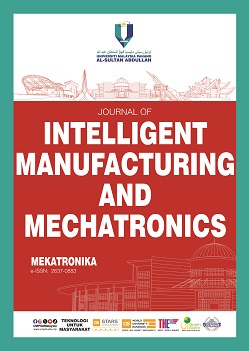A Two-Wheel Mobile Robot Platform for Simulating and Understanding Spacecraft Attitude Dynamics and Control
DOI:
https://doi.org/10.15282/mekatronika.v7i1.12151Keywords:
Spacecraft Attitude Control, PID Controller, Reaction Wheels, Particle Swarm Optimization (PSO), Two-Wheeled Mobile RobotAbstract
This study investigates the design and simulation of spacecraft attitude control using a two-wheeled robot as a model. Spacecraft attitude control is a complex system requiring precision in maintaining the orientation of a spacecraft relative to a desired reference frame. However, due to its complexity, it is challenging to understand the system dynamics directly. Thus, this research simulates spacecraft attitude control by mimicking the system behavior using a two-wheeled, Arduino-based mobile robot. The primary objective is to develop a control system that reads gyroscope data and adjusts the motor speeds to replicate spacecraft stabilization through reaction wheels. Additionally, a PID controller is implemented to control the robot wheel's speed to simulate the operation of reaction wheels. The platform and model were designed using Arduino and tested with system identification techniques. The motor's RPM and transfer function were modeled to analyze and fine-tune the PID controller, which significantly enhanced the system's performance. A Particle Swarm Optimization (PSO) method was used to determine the optimal PID parameters, improving system stability and precision in the movement. The results indicated that the system achieved stability with less than 10% steady-state error, minimal overshoot, and fast settling times, thus demonstrating effective attitude control through PID regulation. The system exhibited the ability to adjust the motor speed based on the yaw angle, thereby simulating the torque-free motion typical of spacecraft. This study demonstrates how combining theoretical modeling, simulation, and hardware implementation can simplify the understanding of spacecraft attitude control.
References
[1] J. R. Wertz, Spacecraft Attitude Determination and Control, Springer Science & Business Media, 2012.
[2] M. J. Sidi, Spacecraft Dynamics and Control: A Practical Engineering Approach, Cambridge University Press, 1997.
[3] T. S. Abdel Aziz, G. I. Salama, M. S. Mohamed, S. Hussein, “Efficient machine learning based techniques for fault detection and identification in spacecraft reaction wheel,” Aerospace Systems, vol. 7, no. 4, pp. 815-828, 2024.
[4] M. Bassetto, G. Mengali, A. A. Quarta, “Drag sail attitude tracking via nonlinear control,” Acta Astronaut, vol. 225, pp. 845–856, 2024.
[5] W. Wu, Z. Jin, A. Zeya, “Attitude estimation using an adaptive generalized complementary filter,” Measurement, vol. 251, p. 117265, 2025.
[6] S. Barman, M. Sinha, “A novel non-singular fast fixed-time sliding mode control and its application to satellite attitude control,” International Journal of Robust and Nonlinear Control, vol. 35, pp. 2184–2198, 2025.
[7] T. Saito, T. Kuwahara, Y. Saito, Y. Sato, “Guidance strategies for controlled Earth re-entry of small spacecraft in low Earth orbit,” Acta Astronaut, vol. 229, pp. 684–697, 2025.
[8] M. Shafiq, I. Ahmad, “A novel fixed-time smooth synchronization controller for stabilizing chaotic spacecraft formation,” Alexandria Engineering Journal, vol. 117, pp. 577–592, 2025.
[9] M. Seddighi, M. Jafari-Nadoushan, “Designing a concurrent detumbling and redirection mission for asteroid mining purposes via optimization,” Astrodynamics, vol. 8, no. 4, pp. 657-673, 2024.
[10] B. C. Kuo, Farid. Golnaraghi, Automatic Control Systems, John Wiley & Sons, 2003.
[11] J. Kennedy, R. Eberhart, “Particle swarm optimization,” Proceedings of the IEEE International Conference on Neural Networks, vol. 4, pp. 1942-1948, 1995.
Downloads
Published
Issue
Section
License
Copyright (c) 2025 The Author(s)

This work is licensed under a Creative Commons Attribution-NonCommercial 4.0 International License.




